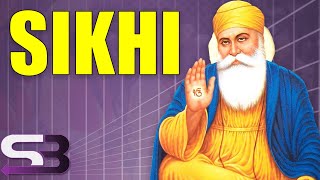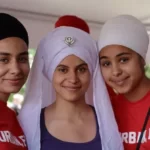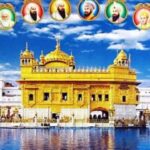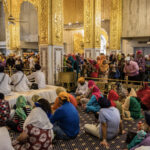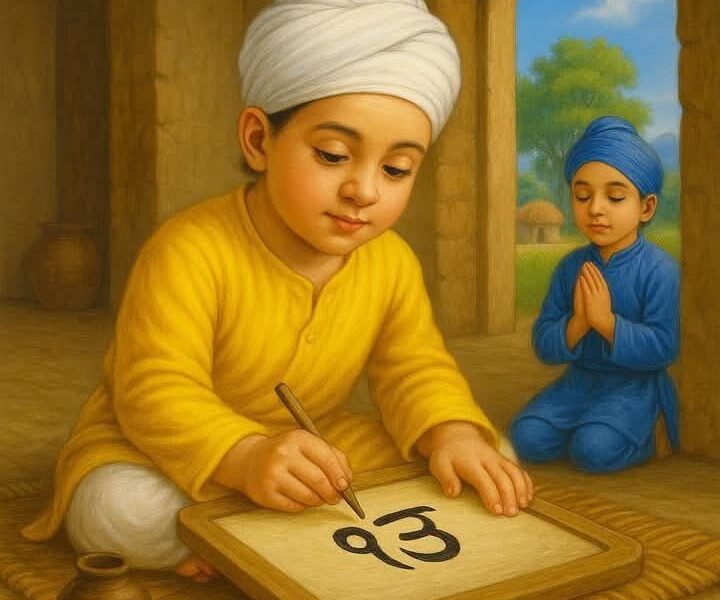In Sikhism, kesh (sometimes kes) is the practice of allowing one’s hair to grow naturally out of respect for the perfection of God’s creation. The practice is one of the Five Kakaars, an external symbol ordered by Guru Gobind Singh in 1699 as a way of calling the Sikh faith. The hair is combed twice daily with kanga, one of five K’s, and tied with a simple knot known as a joora or rishi knot. This hair knot is usually held in place by a charm and covered with a turban.
The 52 precepts of Guru Gobind Singh inscribed on Hazur Sahib in Nanded, Maharashtra province, state that kesh (hair) should be revered as a form of Satguru (eternal guru) whom they regard as the same deity. For this reason, employees are kept with great respect. This includes regular hair care that includes but is not limited to combing at least twice a day, washing regularly, and not allowing for public contact.
Significance
Kesh is a symbol of devotion to God, reminding Sikhs that they must obey God’s will.
Bhai Nand Lal, a well-respected poet in the 10th Guru court, Guru Gobind Singh, wrote in Persian:
Nishān-e-Sikhī ast īn Panj harf-e kāf,
Hargiz na bāshad azīn panj muāf,
Kara, Karad, Kacha, Kanga bidān,
Bina kesh hēch ast total nishān.
[These five K letters are symbols of Sikhism.
These five are the most prominent;
Metal bangle, big knife, shorts, and comb;
With the exception of uncut hair the other four means nothing.]
By not cutting their hair, Sikhs honor God’s gift of hair. Kesh mixed with hair combing using kangha shows respect for God and all his gifts. So much so that Kesh was so important that during the Sikh persecution under the Mughal Empire, the followers were willing to face death rather than shave or cut their hair to hide it. People are dedicated; not cutting their hair is a sign/sign of their interest.
Modern practice
A Sikh boy wearing a patka
In modern times the tendency for short hair to penetrate this tradition. It is estimated that half of India’s Sikh men have thrown away their turban and cut their uncut hair. Reasons include simple comfort (avoiding combing and tying every day) because their parents cut their hair and decide to cut their hair, as well as social pressure from common culture to adjust their appearance to suit the routine.
Kesh (uncut hair) is considered to be the most important part of the Sikh religion and is one of the basic requirements of the Sikh religion. Insulting one’s hair is a serious offense and the perpetrator Sikh is called a “heretic”. Patit is no longer a Sikh. So much so that a Sikh dyeing Kesh or beard is also called tankhahia, a religious sinner with his offerings in Sri Akal Takhat or other Takhat is not allowed. The Sikh does not touch his hair from head to toe because of the Guru’s order to preserve the sanctity of Kesh. The rest means nothing. The Sikhs did what Gugu told them to do.
ਮਾਈ ਸਤਿ ਸਤਿ ਸਤਿ ਹਰਿ ਸਤਿ ਸਤਿ ਸਾਧਾ॥॥
ਬਚਨੁ ਗੁਰੂ ਜੋ ਪੂਰੈ ਕਹਿਓ ਮੈ ਛੀਕਿ ਗਾਂਠਰੀ ਬਾਧਾ ਬਾਧਾ ॥੧॥ ਰਹਾਉ॥
“O mother, Truth, Truth Truth Lord, and Truth, Truth, Truth by God.
The voice, spoken by the Perfect Gugu, I tied to my dress. || 1 || Pause || ”
(Ang 1204)
Living in harmony with Guru’s Tenets “.. A Sikh should not, by any means, dislike the hair of his child born. He should add the ‘Singh’ appendix in the name of his son. A Sikh should keep his sons and daughters’ hair unchanged.” (Page 24)
The value of Kesh can be measured by the fact that a person who despises it is denied even the right to vote in the SGPC election. Regarding the relevant section of the Sikh Gurdwaras Act, 1925:
Section 49 of the Sikh Gurdwaras Act, 1925,
[Provided that no one will be registered as a voter who will-
shaving or shaving his chin or Keshas
The business and ownership of the Sikh depend on each other. While there is no doubt that just by playing uncut hair one will not be a Sikh, but it is also true that without Kes one will not be a Sikh. It is, therefore, explained that everyone who keeps uncut hair does not become a Sikh, but all Sikhs should also be Kesdhari (who keeps uncut hair).
The word ‘Sikh’ literally means a follower. He who does not follow the rules cannot say whether he is called a follower or a Sikh. Uthi Guru Amar Das jee,
ਸਿਖੁ ਸਖਾ ਬੰਧਪੁ ਹੈ ਭਾਈ ਜਿਗੁਰ ਕੇ ਕੇ ਭਾਣੇ ਵਿਚਿਆਵੈ ||
He is the only Sikh, friend, relative and brother, who walks the path of Guru’s Will. (Guru Granth Sahib, 601)
The foundation stone for keeping the uncut hair was laid by the first Guru himself. Guru Nanak made it clear that it is important to keep the hair uncut as this is a blessing from God and to get rid of it is a breach of trust and reckless use. In fact, the Sikh by parting with his kes breaks his relationship with Guru Nanak. The following are excerpts from Makke di Gosht-Guru Nanak Sahib’s interview with Muslim scholars, captured during a visit to Mecca.
The life of the follower must flow through the system. This program is known as rahit mariada. Maryada is a name derived from the Sanskrit word marya, meaning two banks of a river. When water flows between the poles it means that they are a river and help mankind. However, if it spills over or breaks its edge, it means flooding and damage. Similarly, the life of the Sikh should flow and operate within the boundaries of the Maryada and the Maryada should be the Sikh Rahit Maryada. According to Guru Nanak Dev, founder of the Sikh faith,
ਨਾ ਮਰਜਾਦੁ ਆਇਆ ਕਲਿ ਭੀਤਰਿ ਬਾਹੁੜਿ ਜਾਸੀ ਜਾਸੀ | ||
“You have entered this Dark Age of Kali Yuga naked, and you will go naked again if you fail to lead your life in Maryada.”
(Guru Granth Sahib, 74)
Every religion has its own rules and regulations. It is obligatory for a believer to respect the feelings, emotions, and codes of all other religions. Guru Gobind Singh was asked by a royal colleague, the emperor scholar Bahadur Shah: “Which of the two religions is better, yours or mine?” Guru ji’s reply was, “tum ko tumahara khoob, hum ko hamara khoob – yours, yours. it is a miracle and for me, mine is right. ” It is therefore very clear that the Sikh Rahit Maryada or Sikh Code of Conduct governs the lives, actions, actions, and omissions of the Sikhs only. It does not interfere with any other religion or religious group and will not invite any interference from any other.
The Kesh and the Keski (hat) are the divine gifts from the Creator, the Guru. Discarding these key ‘topics of faith’ through Sikhism is a deliberate act of contempt for the will of God and Guru.
Didaar, guftaar, and kirdaar – appearance, dialogue, and inner character, are three boundaries of human judgment and evaluation. The last two steps come in handy when one can easily fall into the same category.
